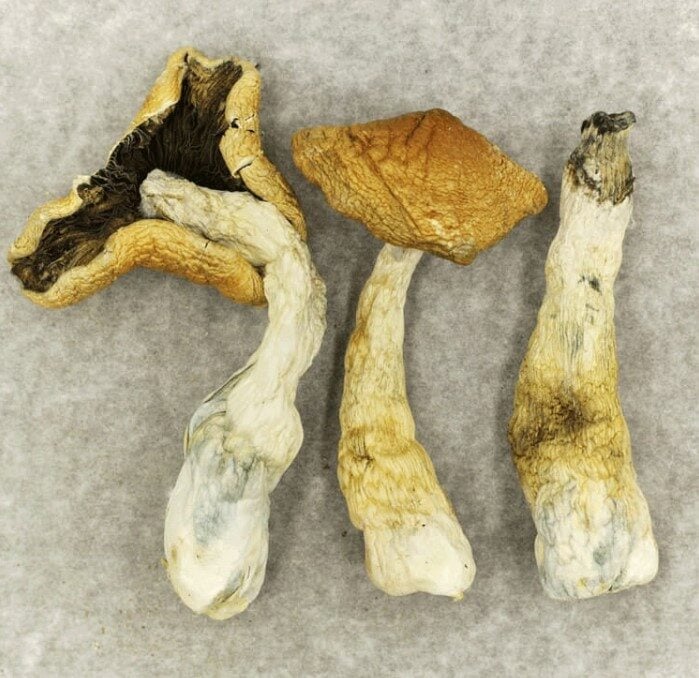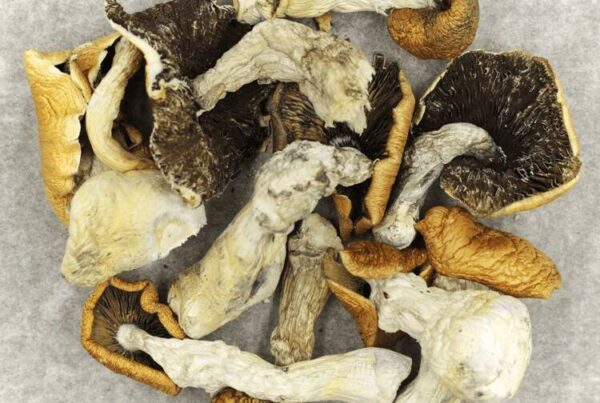The Full Moon Party mushroom strain has high psilocybin content, a natural compound popularized for its therapeutic benefits. These species are being studied as a possible way to help with eating disorders, including anorexia nervosa (AN).
Researchers are now exploring whether therapies with shrooms could bring new hope to people struggling with AN by addressing its deep psychological roots.
Table of Contents
Key Takeaways:
- Psilocybin mushrooms show potential for treating anorexia by disrupting rigid thought patterns and improving emotional well-being when paired with psychotherapy.
- A clinical trial showed that 90% of participants viewed psychedelic therapy as meaningful, with 60% reporting less focus on body image and 70% noting improved quality of life.
- While many patients experienced emotional improvements, significant weight restoration was not achieved.
Psilocybin and Anorexia Nervosa (AN)
AN is a serious mental health disorder where people have an exaggerated fear of gaining weight. They see their body as larger than it is and use strict eating restrictions to cope. This can lead to dangerous malnutrition and severe health problems.
Anorexia has one of the highest death rates among mental illnesses. Sadly, there are no effective medications. Current treatments like family-based sessions only lead to recovery in about 38% of cases, and specialized therapies perform no better than basic support methods.
Additionally, there are no proven medications to treat AN, which leaves many patients in prolonged suffering. This highlights the urgent need for new approaches.
One potential option is psilocybin, a compound found in magic mushrooms. The compound can alter thinking, emotions, and perceptions. This helps disrupt rigid thought patterns linked to anorexia. The treatments paired with structured psychotherapy sessions guide patients to understand and apply the changes in their thinking.
Psilocybin vs. Conventional Treatments
Psychedelics help by boosting brain connections, which allows patients to see things from new perspectives and loosen their focus on control and perfectionism. For those dealing with this condition, this can address deep-rooted issues like trauma, distorted body image, and perfectionist thinking.
Unlike traditional approaches, it encourages emotional breakthroughs and helps shift rigid mental patterns. After undergoing therapies, many patients feel more open to change and less burdened by fear.
The choice of mushroom strain is also important, as different strains have different effects. The Full Moon Party Mushroom Strain, known for its uplifting and energizing qualities, could be particularly helpful for easing rigid thinking and emotional tension.
What is Full Moon Party Mushroom Strain?
These Psilocybe mushrooms are the Koh Samui Super Strain (KSSS), a unique mushroom species of Psilocybe Cubensis with a fascinating history and exceptional characteristics.
Its name honours the famous Full Moon Party held on the tropical Thai island of Koh Pha Ngan, where these fruiting bodies are popular among revellers for their euphoric and energetic effects. For centuries, they have been used in traditional Thai medicine to address anxiety, depression, fatigue, and memory.
This strain thrives when cultivated using grain spawn and is particularly suited to substrates like wood chips.
Characteristics of Full Moon Party Mushroom Strain
| Physical Appearance | Thick, stubby white stems with golden to yellow caps. |
| Potency | Above-average tryptamine levels. |
| Cultivation and Growth | It thrives in tropical climates or dense clusters. This requires humidity control, heat, and light for cultivation. |
| Effects | -Offers a powerful psychedelic experience, beginning with a head high that evolves into intense visual hallucinations. -Creates feelings of euphoria and heightened energy, ideal for social settings. |
| Benefits | Manage little to severe mental health issues such as anxiety and depression based on traditional and modern use. |
Compared to other dried mushrooms, like Psilocybe semilanceata or Psilocybe cyanescens, this strain is renowned for its psychoactive properties and euphoric effects. This has drawn the interest of researchers, mushroom fanatics, and those exploring new drugs for mental health treatment. Similar to other hallucinogens like LSD, its effects can differ greatly based on the dose and individual tolerance.
What Does the Study Say?
The alarming high mortality rate of anorexia among psychiatric disorders brings researchers at the University of California, San Diego (UCSD) to analyze a clinical trial on psychedelic therapies for treating anorexia nervosa.
Methods
An open-label feasibility study tested the safety and tolerability of a single 25-mg dose of synthetic magic mushrooms in 10 adult females meeting DSM-5 criteria for AN or partial remission (pAN).
This was combined with specialized psychological support sessions before, during, and after. Researchers used interviews and participant feedback on adverse events (AEs), electrocardiogram changes (ECGs), lab tests, vital signs, and suicidality post-treatment. They also focused on participants’ subjective experiences during the session to identify patterns and trends.
Results
The trial showed promising safety results with no serious side effects. Heart function, vital signs, and mood stayed stable throughout.
Two participants had mild hypoglycemia (low blood sugar), but it resolved within 24 hours. Researchers linked this to the fasting required for the trial, not the hallucinogenic compound itself. Other mild side effects included headaches, nausea, and fatigue.
Most patients found the treatment meaningful, with 90% reporting a more positive outlook. Many felt one session wasn’t enough and suggested multiple treatments might be more effective.
One participant shared, “You can act in a way that maybe had felt unachievable before if you set the right intention.” Importantly, all participants stayed engaged, with no dropouts.
Exploratory Results
- About 60% of participants felt less focused on their physical appearance, like body shape and weight, while 70% noticed a better quality of life and shifts in their identity.
- Four in ten participants showed big improvements in eating disorder symptoms, especially around body shape and weight concerns.
- 40% scored in the “normal” range on the Eating Disorder Examination, meaning their symptoms were less severe.
- BMI didn’t change much overall. Some participants gained weight, others stayed the same, and a few lost weight, suggesting the compound’s effects might be more psychological than physical in the short term.
- Even with these emotional improvements, many participants didn’t fully restore their weight, pointing to a gap between mental changes and physical recovery.
How to Integrate Psilocybin Therapy for Anorexia Nervosa
Psychedelic-assisted treatment takes a fresh approach to mental health by tackling both psychological and emotional challenges. For AN, it can ease symptoms, boost mindset, and encourage a healthier connection with food and body image. It works best when paired with counselling, medical care, and support for overall well-being.
Here are some safety tips to follow:
- Always conduct treatment in a clinical setting with trained professionals.
- Check for any mental or physical conditions that might make psychedelics unsafe.
- Create a safe, calm, and supportive session environment.
- Minimize fasting requirements to reduce risks like low blood sugar. Avoid alcohol consumption.
- Watch for mild effects like nausea or headaches and address them promptly.
- Offer ongoing support to ensure lasting benefits and address any challenges that arise.
Closing Thoughts
The study suggests that using psychedelic treatments, like those involving shrooms online, could help people with anorexia by reducing appearance concerns and improving their quality of life. But it’s not a complete fix and works best alongside other treatments.
Researchers say more studies are needed to understand why some people respond better than others. They suggest examining genetic differences and brain imaging to determine who might benefit most.
Frequently Asked Questions
What is the process of psilocybin-assisted therapy?
To feel the hallucinogenic effects, the session involves three phases:
- Preparation. Sessions with a therapist to establish trust and set intentions.
- Dosing Session. Taking doses under professional supervision in a safe, controlled environment.
- Integration. Post-session therapy to process and integrate the insights gained.
How long do the effects of psilocybin last after a therapy session?
The hallucinogenic properties of shrooms can last 4–6 hours during a session. However, the psychological benefits, such as reduced anxiety and improved mood, may last weeks to months. Ongoing therapy and integration are important for maintaining long-term benefits.
How many psilocybin-assisted therapy sessions are needed to see benefits?
The number of sessions varies by individual and study protocols. Many clinical trials involve one or two high-dose sessions, complemented by preparatory and integration treatment. Some individuals may benefit from additional sessions.





